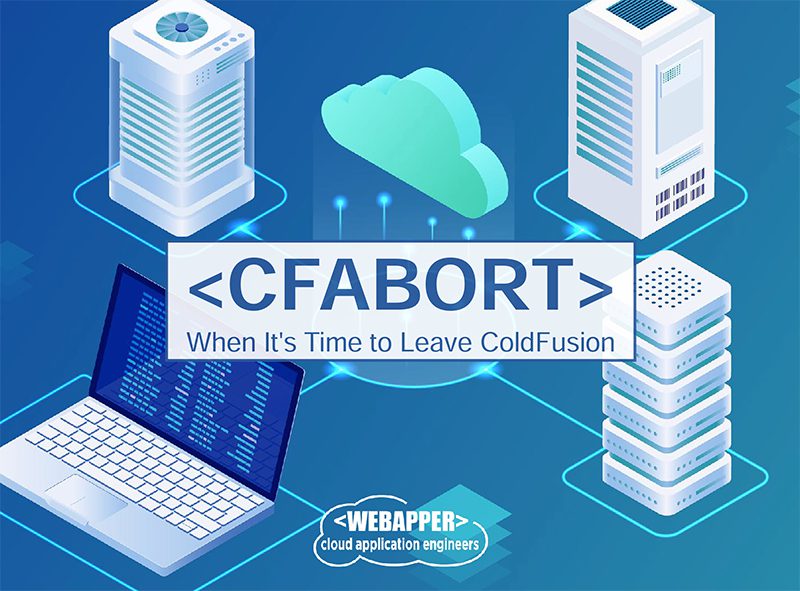Why ColdFusion 2021 Might Be Your Off-Ramp from Adobe ColdFusion
Back in the mid-90s, a little company named Allaire built a dynasty within the web development community after introducing ColdFusion. Delivered as an affordable, easy-to-implement application server, ColdFusion included a familiar tag-based programming language (CFML) that enabled data-driven web applications. The roots of Webapper’s expertise in web application development go back to those early days (version 1.6!). Over twenty years later, with ColdFusion being in the hands of Adobe for fifteen of them, Adobe announced the release of ColdFusion 2021 (2.5 years after the last major release), which may delight some, but will most likely drive many loyal users away. As painful as it can be, we present the case for why we think ColdFusion 2021 might be the time for you consider taking an off-ramp from Adobe ColdFusion (hint: Webapper is perfectly positioned to help).
Adobe ColdFusion 2021 Licensing Costs
At the top of the list of reasons to mothball ColdFusion are the licensing costs. Adobe has clearly decided to milk the top of the market – those government and enterprise customers who are heavily reliant on ColdFusion – by maintaining an antiquated licensing model. We laugh when we hear their 90s pricing models mentioned in the realm of modern cloud computing. They just don’t fit.
Adobe ColdFusion 2021 is sold in two forms: the Standard Edition is $2,499 for two cores, and the Enterprise Edition is $9,499 for eight cores.
ColdFusion Standard 2021 provides a limited feature set for applications with moderate traffic. ColdFusion Enterprise 2021 is designed for higher traffic applications in clustered environments and with need for enterprise grade features and integrations.
An additional disadvantage of Adobe’s cores-based licensing model is that it’s per-server (regardless of whether virtual or physical), which further adds to the costs. You can’t, for example, buy one Enterprise license and run a cluster of four 2-core server instances. License-included cloud offerings such as the official ColdFusion image in the AWS Marketplace can actually be substantially more expensive than the pricing options noted here (and the AWS Marketplace offering has historically been Enterprise-only, with no option to use Standard edition).
ColdFusion 2021 Isn’t True Cloud Computing
Cloud computing design patterns, such as microservices and serverless architectures for systems and software, reflect a critical trend with profound implications for enterprise IT. Taking a monolithic architecture to microservices represents a fundamental shift in how IT approaches software development. By its very nature, Adobe ColdFusion is a monolithic architecture, with a large-footprint and centralized application runtime. As such, putting ColdFusion in the cloud isn’t true cloud computing. Yes, it resides in a cloud environment, but it’s not leveraging the greatest advantages of the cloud. ColdFusion 2021 represents Adobe’s first attempt at adapting the product to the cloud, including ‘transitional’ features that begin to leverage cloud architecture. The question becomes whether it’s worth continuing expensive investment in the monolith or transitioning to a native cloud platform
Note, the same can be said of Lucee, the F/OSS CFML engine, with which Webapper has deep and broad expertise. There are some key differences, however, between Lucee and ACF as monolith application servers. First and foremost, Lucee is the same price for 8 or 16 or 32 cores, or 8 or 16 or 32 servers — $0. (P.S.: the Lucee Association does need your membership if you’re running significant systems on Lucee!). More importantly, the legacy monolith design problem is being aggressively addressed by the Lucee development team, including plans for serverless/headless deployment in the next major Lucee release).
The Shrinking CFML Talent Pool
One of the challenges of using older technologies is the shrinking number of developers. We receive resumes from veteran CFML developers who have nowhere to go. It’s a shrinking job market, and although 20 years of experience sounds tempting, the salaries are commensurate. It’s hard for us to say it, but we are ultra-selective, and it’s hard to find versatile, experienced, affordable ColdFusion talent. Any hiring manager who has contrasted the CFML-guru and Python-guru talent pools will immediately understand what we’re saying here. We find the upper end of the Python developer salary range to be near the floor of the ColdFusion range. And Python’s a growing pool – it is the second most popular programming language in 2021.
The Adobe ColdFusion 2021 Off-Ramp Decision
If you’re on a road trip and your fuel starts getting low, you look for “the best exit” — one that will address multiple issues like affordable gas, clean restrooms, decent food, and easy on/off access. Similarly, you should consider how to exit ColdFusion gracefully. Is there a way to transition easily, without running up exorbitant bills, that keeps your operation going for the long haul? Having a cloud partner who understands the roadmap helps. You could take a number of routes…
- Stay with Adobe ColdFusion (status quo).
- Switch from Adobe ColdFusion to Lucee (changing course slightly, with better near-term options for true cloud design).
- Rewrite portions of the application as cloud native (minimize ACF expenses while using the “strangler” pattern to slowly replace monolith components).
- Rewrite the entire application as cloud native (most divergent).
At Webapper, we understand all these options, and we understand that no one path works for everyone. We recommend discussing your options internally and then having a chat with cloud specialists. Knowledge of ColdFusion development is paramount in those external discussions in order to provide a reasonable, realistic roadmap. The most important factor is that if there are elements to repurpose, you can save time and money. Ultimately, for small- and medium-sized businesses, it’s increasingly urgent to make your Adobe ColdFusion 2021 off-ramp decision – stay on the same road or take one of the alternative routes.
For larger enterprises and applications in the cloud, we can help you get the best possible ROI from staying with Adobe ColdFusion while leveraging the numerous benefits of true cloud infrastructure.
If you have additional questions about cloud migration or our cost optimization on AWS, please contact us.



Leave A Comment